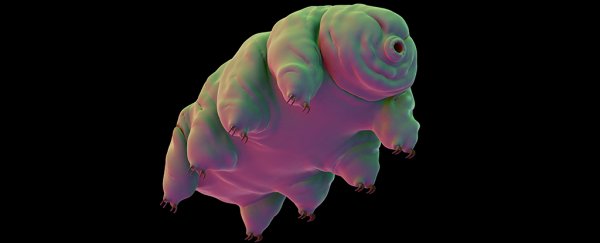A fresh analysis of the tardigrade's genome has revealed new secrets about the world's toughest animal, while casting doubt on a previous conclusion.
By comparing the genes taken from two different species from the phylum Tardigrada, researchers determined how the group is related to other animals while pinpointing the genes that allow individuals to survive being dried to a husk.
The international team of researchers led by the universities of Edinburgh, Scotland and Keio, Japan, sequenced genes taken from the species Ramazzottius varieornatus and Hypsibius dujardini and compared them with other animals that most closely resemble the tardigrade.
At barely a millimetre (about 0.04 inches) or so in length, the tardigrade – also commonly called a water bear or a moss pig – is an unlikely candidate for world's toughest animal.
But don't let that size fool you. Recent research has found they'd be busy dancing on your remains long after an astronomical apocalypse has rained terror down on our planet.
This resilience comes down to a bunch of rather neat party tricks; the water bear can survive temperatures ranging from as high as 150°C (302°F) down to near absolute zero, starve for as long as a decade, and be completely dried into suspended animation, only to return when conditions are more suitable.
Earlier research by another team of researchers had discovered this ability to withstand near complete desiccation could come down to a kind of protein-based "bioglass" that holds their cellular structures into place until water returns.
To find exactly which genes might be involved in this complex process, the scientists in this new study mapped which genes were working hard as the two species of water bear were dried out and rehydrated.
As might be expected, a large proportion of the expressed genes were involved in DNA repair, a feature which could also be exploited after being hit with huge doses of radiation.
Other genes helped to protect DNA from oxidation damage.
Comparing the complete genomes also answered a question that had long vexed biologists – just where in the family tree did this odd little creature sit?
Water bears belong to their own phylum called Tardigrada.
On one hand, their segmented bodies make them look a little like tiny insects, so their branch could sit close to the crabs, spiders, and bugs that make up Arthropoda.
They have eight stumpy legs and a long body, so it's also possible they could instead lean towards being a distant relative of Onychophora, which are caterpillar-shaped animals also known as velvet worms.
Previous research using genetic sampling had discovered links between tardigrades and round worms, or nematodes.
Counting the number of so-called HOX genes involved in establishing the sequence of body segments in all animals backed up those earlier studies, finding the Tardigrade had five HOX genes just like those in the phylum Nematoda.
While it's not proof positive that the two groups are closely linked, it would be a remarkable coincidence since most other animals have ten of those genes.
The research is far from the only study to have analysed the genes of this tiny superbeast.
A couple of years ago, a study concluded that a whopping 17.5 percent of the tardigrade's genome – that's about 6,000 genes – were picked up from other species. Most of them bacteria and other microbes.
While we all have a few genes that skipped across from another organism through what's called horizontal gene transfer, that's a huge fraction of foreign genes for an animal.
According to this new study, we can rule out tardigrades having a Frankenstein's monster of a genome.
The researchers found no sign of bacterial DNA, hypothesising that previous conclusions might have been based on contamination.
"I have been fascinated by these tiny, endearing animals for two decades. It is wonderful to finally have their true genomes, and to begin to understand them," says researcher Mark Blaxter from the University of Edinburgh.
Discovering how tardigrades repair their DNA and protect their cells against heat and radiation could have applications in tissue preservation or other forms of biotechnology.
"This is just the start," says Blaxter.
"With the DNA blueprint we can now find out how tardigrades resist extremes, and perhaps use their special proteins in biotechnology and medical applications."
This research was published in PLOS.
